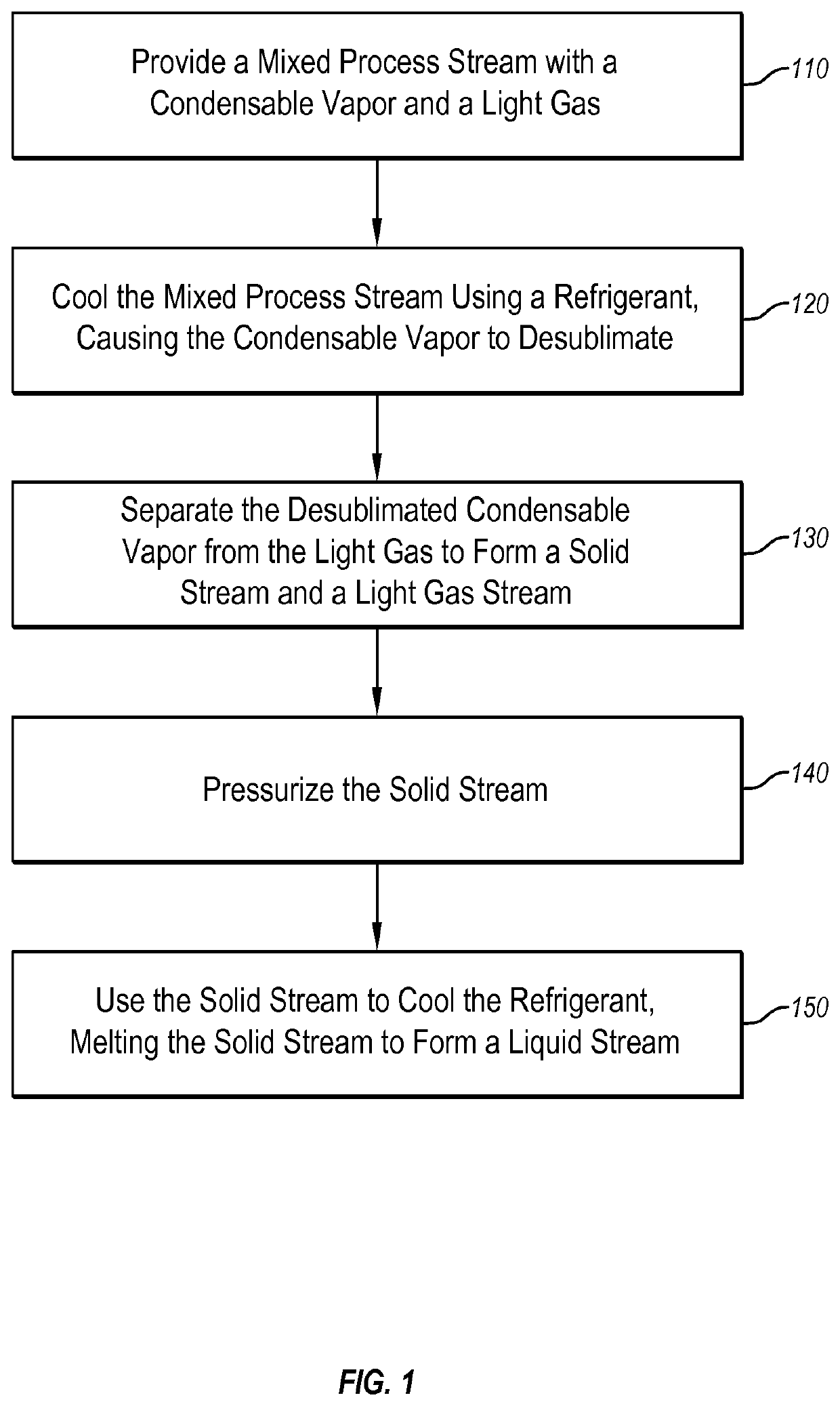Systems and methods for separating condensable vapors from light gases or liquids by recuperative cryogenic processes
a technology of recuperative cryogenic process and condensable vapor, which is applied in the direction of separation process, liquefaction, lighting and heating apparatus, etc., can solve the problems of system efficiencies that greatly exceed conventional methods, and achieve the effect of efficient recovery of energy used
- Summary
- Abstract
- Description
- Claims
- Application Information
AI Technical Summary
Benefits of technology
Problems solved by technology
Method used
Image
Examples
example 1
[0120]Example 1 shows the merit of two cryogenic carbon capture processes implemented according to the invention such that it is configured as the double-ECL system shown in FIG. 6 and with an UHE analogous to that shown in FIG. 5. One of the processes is implemented with a simple assumption that the process stream contains N2, O2, and CO2; the other is under a complex assumption that the process stream further contains S, N, Hg, and Cl impurities. The systems also meet the general equipment requirements as stated above.
[0121]Table 1 below summarizes all essential stream conditions and figures of merit. The major equipment energy requirements also appear in Table 1. One of the notable advantages of the invention is that it operates at temperatures considerably warmer than air separation units and therefore enjoys a much broader choice of materials since most common materials of construction are appropriate in the cryogenic carbon capture conditions but many become too brittle or oth...
example 2
[0123]Example 2 uses both laboratory experiments and simulations to determine carbon capture efficiency as a function of temperature in a system implemented according to the invention. Example 2 also shows the energy consumptions as functions of capture efficiency and compression efficiency.
[0124]The systems are implemented with configuration similar to those in Example 1. Repeated laboratory experimental measurements using both simulated and actual coal process gas and using both simulated gas expansion devices (gas expansion through nozzle with external cooling) and refrigerant expansion devices have demonstrated capture efficiencies as shown in FIG. 9, where the discrete data points show empirical data and the solid line represents model prediction matching the empirical data.
[0125]FIG. 10 summarizes the specific energy consumption as functions of capture efficiency and compression efficiency—two prominent parameters, assuming an average 10° C. temperature difference in the heat ...
example 3
[0129]Example 3 shows simulated energy demand data for various embodiments of the invention applied to CCC under different assumptions and parameters, the systems having similar configuration as those in Example 1 and 2.
[0130]Extremely high capture efficiencies require far more energy than theoretical analyses suggest. Indeed, while the theoretical energy costs of perfect separation (100% capture and 100% pure) are finite; there is no continuous industrial process that can achieve this limit with finite energy. The CCC process, however, does not incur rapidly increasing energy costs until close to this limit, as shown in FIG. 10. The entire CO2 flow can only be captured by this technique by going to absolute zero, where vapor pressures are zero but which requires infinite energy. However, temperatures of −130° C. represents greater than 99% capture of an initial 14% flow. The results from these more detailed analyses appear below.
[0131]Table 2 is a compilation of the various process...
PUM
 Login to View More
Login to View More Abstract
Description
Claims
Application Information
 Login to View More
Login to View More - R&D
- Intellectual Property
- Life Sciences
- Materials
- Tech Scout
- Unparalleled Data Quality
- Higher Quality Content
- 60% Fewer Hallucinations
Browse by: Latest US Patents, China's latest patents, Technical Efficacy Thesaurus, Application Domain, Technology Topic, Popular Technical Reports.
© 2025 PatSnap. All rights reserved.Legal|Privacy policy|Modern Slavery Act Transparency Statement|Sitemap|About US| Contact US: help@patsnap.com



